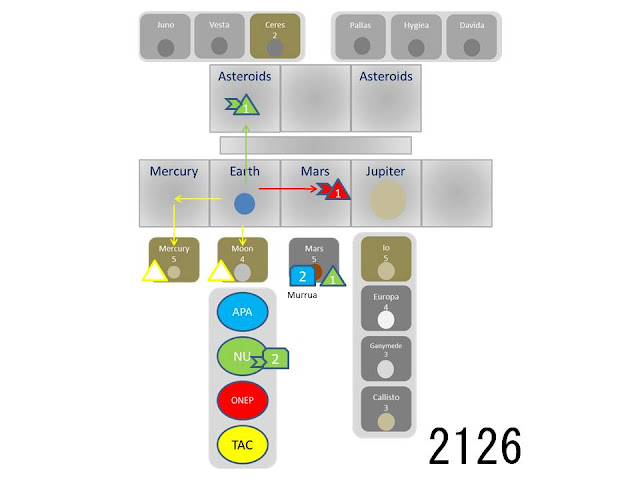Introduction
The first turn of my solo replay of The Final Frontier.
Narrative
It is now 2125 and other powers have also taken an interest.
The Asia-Pacific Association (APA) has stalled after colonising Mars and is
building momentum to expand Murrua (the Martian colony). However this will take several years.
Meanwhile the Northern Union (NU) has solved its production
issues and launched two mines – one established on Mars and the other on the
way to Ceres. So far the APA seemed to
not see the NU mine of Mars as a threat and happy to co-operate. The NU colony is ready to go to Mars once the
mine is established.
The Organisation of Nations for Economic Prosperity (ONEP)
is fired up with space enthusiasm and a research breakthrough on power beaming
in recent years allows for expansion to Jupiter, something the other powers do
not have the infrastructure to support.
The ONEP quickly put together a mine and send it toward the Jovian
system. Hopefully this will keep them
out of the possible tensions that are bound to arise in the inner system.
The Americas Co-operative (TAC) nations commit a greater proportion of their GNP to get the space program off the ground. This gives them an edge in building capacity and determine to use this to its fullest. Rather than focus on the tempting target of Mars, they pour all their efforts into Mines on the more costly implementations at Mercury and the Moon. They were still not operational by the end of the year, but by the time they are completed next year they will be pumping out more resources than any other power, from mines anyway.
Game notesThe year is 2126.
APA (NIL 1) has a GNP of 110 (100 base plus 10 income).
Carryover 2BP +2BP for a total of 4BP.
NU (NIL 1) has a GNP of 100 (100 base plus 0 income).
Carryover 0BP +12BP for a total of 12BP. 11BP spent on two mines with DST and a
colony-2 with DST, leaving 1BP. Move a mine to Mars and now operating. Move a mine towards Ceres.
ONEP (NIL 3) has a GNP of 100 (100 base plus 0 income).
Carryover 0BP +3BP for a total of 3BP. 3BP spent on a mine and a DST, leaving
0BP. Move the mine towards Jupiter.

